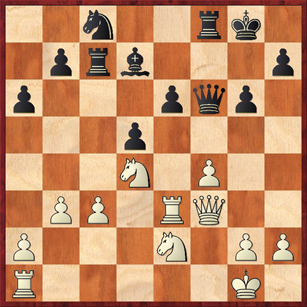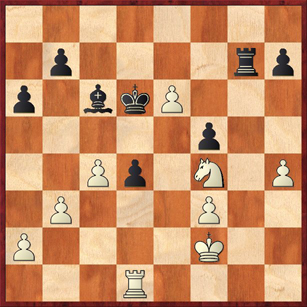In the fourth round of the Santa Cruz Cup I played my best game yet (which isn’t saying much). I’m now sitting in very good shape, with a 4-0 start including wins over my two highest-rated opponents. However, there’s a lot of chess remaining. Ratings don’t mean that much when everybody is bunched up within 100 or 150 points.
I won the game primarily because of a nice tactical shot (see below) that came just when it seemed as if the game might be turning in my opponent’s favor. I played a clean game with no mistakes, except right before the time control, where Fritz finds an elegant win that I missed. Here are the two most interesting positions of the game.
Dana Mackenzie – Dan Burkhard, White to move.
Dan had just played 22. … Nb6-c8, a superficially very attractive move because it threatens to bring the knight to e4. However, White seizes the advantage with a tactical idea based on the undefended position of his rook on c7. Can you find it?
Mackenzie – Burkhard, White to move.
Black has just played 37. … Ke7-d6, hoping to play … Ke5 removing the defender of White’s advanced pawn on e5. In this position I settled for 38. Rxd4+? Ke5 39. Ke3 and now Dan gave me an early Christmas present with 39. … Bxf3?? 40. Nd3+! resigns. However, he could still have put up a fight with 39. … Rg3 40. Nd5 Kxe6 41. Kf4. White will probably win eventually, but he’s still go some work to do.
Instead of 38. Rxd4, Fritz finds a beautiful forced win for White, based on some tricky knight maneuvers. Can you see it?
Answer to first problem: I played 23. f5! The main point is 23. … gf? 24. Qg3+, winning the unprotected rook on c7. Another important point is that if Black tries to set up a pin on the f-file with 23. … Qh4 (or any other Queen move), White can break the pin with 24. Nf4!, threatening a knight fork on e6. Finally, if 23. … ef 24. Qxd5+ (24. Nf4 is also good), White has a dominating position.
Answer to second problem: The move I missed was 38. Ne2! This is a pretty straightforward move, but what comes after it is really cool. Black must play 38. … Kxe6, because otherwise he will be two pawns down with no compensation. Then comes 39. Nxd4+ Ke5 40. f4+! (the key move!) and Black’s king has no good squares:
a) 40. … Kf6 41. Nxc6 bc 42. Rd6+ and White mops up all the queenside pawns;
b) 40. … Kxf4 41. Ne6+ wins the rook;
c) 40. … Ke4 41. Ne6! threatens 42. Rd4 mate! Note also that Black’s king interferes with the bishop, so that 41. … Rg2+ is impossible. Instead Black’s only defense is 41. … Rd7, but now White wins with another fork, 42. Nc5+.
What an amazing line! With only a couple minutes left before the time control, I didn’t even come close to finding this. It would have been a great way to finish off the game.





{ 3 comments… read them below or add one }
I saw the first one, after some thought. In the second one, I saw untill Nxd4, but thought the idea with that would be to exchange the Bishop for Knight, and since that didn’t look really good, I didn’t analyse further to see the awesome f4 move. To see that, it’s actually necessary to sit an conceptualize when you calculate, so you have to hold the position in your head while thinking about it. I used to just calculate by having 2-4 pieces dance around on the board and see if I could grap any material/big advantage at the end of their dance (missing a lot of the rest of the board). Now I think it’s fun to pause in the middle of lines to “see” the future position as a whole, midway through, and evaluate the positional factors. I think if you’re really good at doing that, then you find stuff like that line.
This f5 move making way for the Knight to occupy the f4 square is illustrated in an excellent presentation at chesslecture dot com called “Shifting gears between strategy and tactics.†There Dana argues convincingly that to be a really good player you have to be a bit schizoid, play like Capablanca one move and like Lasker the next and that this ability is both desirable and very hard to come by indeed.
In order to commit to memory this manoeuvre, this small module of knowledge where you push, sacrifice if need be, a pawn to gain access to the vacated square by a Knight I suggest we give it a name (you name it you own it): my vote is for “The Mackenzie Shuffleâ€.
Carina – Good for solving the first puzzle! The second one is harder, I think, because the first two moves are so routine and then the move 40. f4+! just comes out of nowhere.
Dribbling – You’re right, this is a pretty good example of the “Shifting gears” theme. Prior to this move, my opponent and I were playing mostly strategically. I was thinking about moving my knight to e5 to blockade the e6 pawn and imprison his bishop, and obviously his move … Nc8 was designed to maneuver the knight to e4. The tricky thing, for me, was to switch out of strategic mode and realize that his knight move had created a tactical opportunity. I was very glad that I was able to do this, given the fact that I had failed to “switch gears” in that game I lectured about.
I’m flattered that you want to name the move f5 after me, but really it’s just a clearance sacrifice, vacating f4 for the knight and also clearing the diagonal g3-c7 for the queen check. At the same time, it also has some Nimzovichian aspects — it undermines the d5 pawn (undermining) and it eventually prevents the Black knight from coming to e4 (prophylaxis). So, a multi-purpose move!